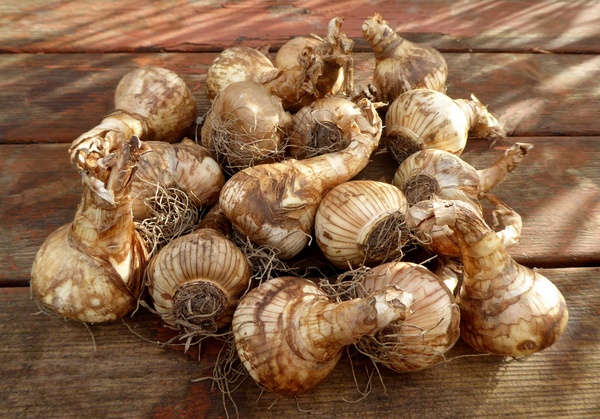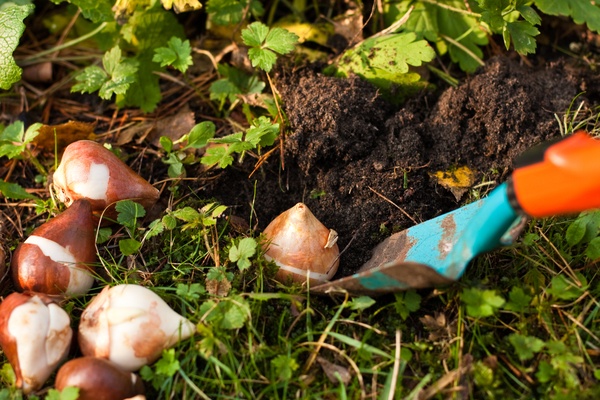Daffodils are one of the most popular spring-flowering bulbs. They are relatively easy to grow and maintain, and they come in a wide variety of shapes, sizes, and colours. This guide will teach you everything you need to know about growing daffodil bulbs, from planting to propagation.
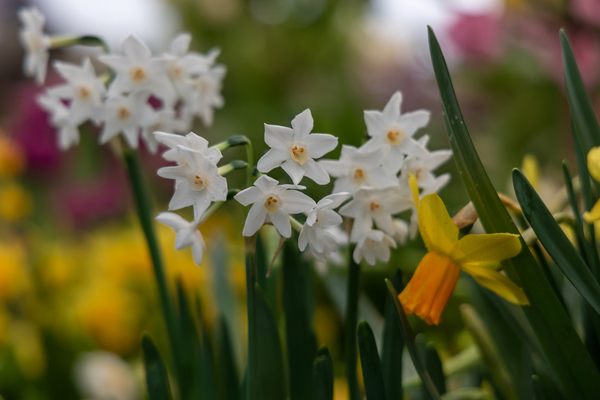
Daffodils are from the Narcissus family of plants, and they are sometimes referred to as jonquils or paperwhites. They are native to Europe and North Africa, and people have been growing and enjoying them for centuries. While there are hundreds of different types, the most common is the yellow trumpet daffodil, which has a long, slender trumpet-shaped bloom.
Growing Daffodil Bulbs
What You’ll Need
- A packet of daffodil bulbs
- A sunny spot in your garden
- Well-drained soil
- A dibber tool or something to make a hole in the soil
- Water
What are Daffodil Bulbs and What do They Look Like?
Daffodil bulbs are small, round, and typically white or yellow. They have a thick outer layer that protects the bulb from drying out. The innermost layer is the food storage tissue, and the middle layer is the growing tissue. Daffodil bulbs most commonly bloom in the spring, but some varieties will bloom in summer.
When buying daffodil bulbs, look for ones that are plump and firm. Avoid bulbs that are soft, mushy, or have any signs of mould. It’s also a good idea to buy bulbs from a reputable source to ensure that they are disease-free.
Where to Plant Daffodil Bulbs
Daffodil bulbs should be planted in well-drained soil in a sunny location. They do not like wet feet, so make sure the planting area is not prone to flooding or waterlogging. If your soil is heavy clay, you may want to consider planting daffodil bulbs in raised beds or mounds.
Besides looking great in beds and borders, daffodils also naturalise very well in grass areas. This means that they will come back year after year and spread slowly over time. You can also plant them in containers or even make a spring flowering hanging basket.
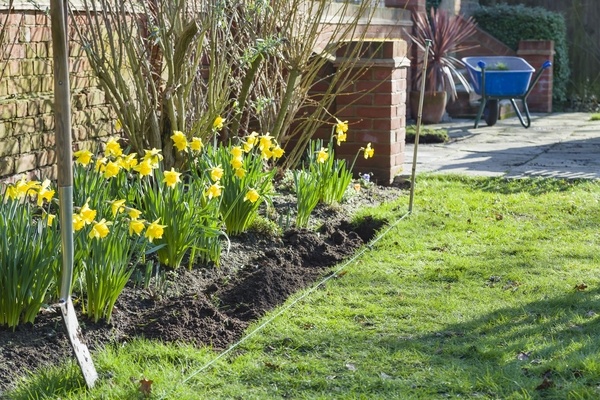
When to Plant Daffodil Bulbs
The ideal time to plant daffodil bulbs is in the autumn, about 6 weeks before the ground freezes. Here in the UK, that usually means September is a good time. This gives the bulbs time to develop roots before winter sets in.
Of course, if you’re planting a more unusual, summer flowering variety, then you’ll be planting in the spring around April to May.
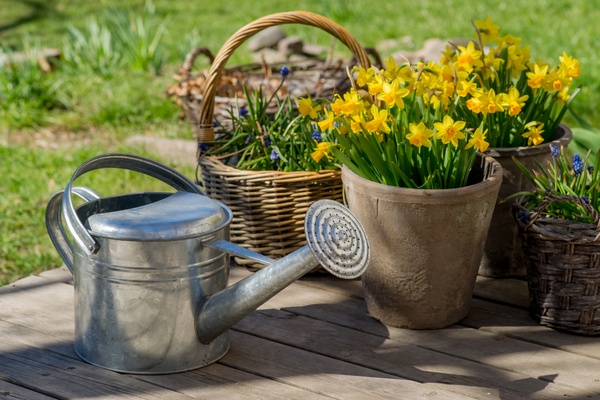
How to Plant Daffodil Bulbs
To plant daffodil bulbs, dig a hole that is two to three times the height of the bulb. Place the bulb in the hole with the pointed end up, and cover with soil. It’s best to space the bulbs at least a few inches apart, so they have room to grow. Water them well and that’s pretty much it! If you’ve planted them in a good spot, then your bulbs should keep giving you flowers to enjoy year after year.
Note for containers: if you’re planting in containers and planning to lift the bulbs after flowering, then you can be slightly less fussy and pack the bulbs together for a brilliant display.
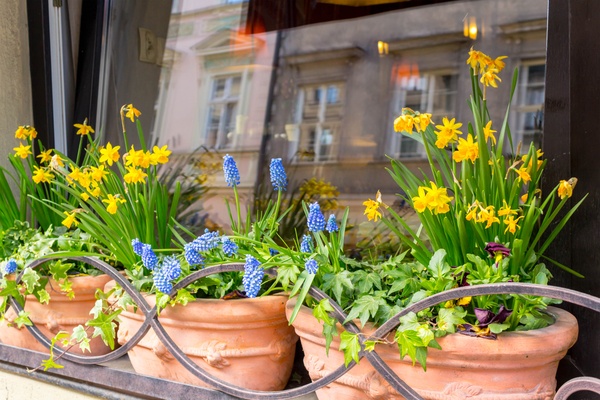
How to Care for Daffodil Bulbs
Once they are planted, daffodil bulbs don’t need a lot of care. They are pretty drought tolerant, so you don’t need to water them too often. Over-watering can be a problem as it can encourage fungal diseases.
During the growing season, you can fertilise your daffodil bulbs with a balanced fertiliser to encourage strong growth. Apply the fertiliser in early spring, before the plants start to bloom.
Once the blooms have faded, it’s important to let the foliage die back naturally. This is because the leaves are still photosynthesising and storing energy in the bulb for next year. Once they have died back, you can cut them off at ground level.
After a few years, daffodil bulbs can start to get crowded and flowering may decline. This is a good time to dig up the bulbs and divide them. Replant the larger bulbs immediately, and discard any that are small or have started to rot.
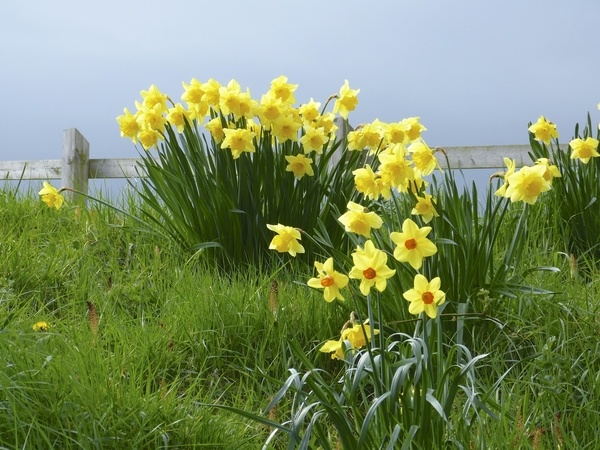
How to Propagate New Daffodils From Old Ones
Daffodil bulbs can be easily divided to create new plants. This is best done every few years, and after the plants have flowered. Carefully dig up the bulbs, and then use a sharp knife to divide them. Each bulb should have a small offset (or ‘baby’) bulb attached. Replant the larger bulbs immediately, and discard any that are small or have started to rot.
You can also propagate daffodils from seed, although this is a slower process and it may be several years before you see any flowers.
Troubleshooting Problems when Growing Daffodil Bulbs
Daffodils are generally pretty trouble-free, but there are a few problems that you may encounter.
The most common problem is bulb rot, which is usually caused by over-watering or planting in poorly drained soil. If you notice any signs of mould on the bulbs or foliage, then it’s important to remove affected plants and bulbs immediately to prevent the disease from spreading.
Finally, slugs and snails love young daffodil shoots, so it’s important to keep an eye out for these pests. Read our guide: How To Get Rid of Slugs and Snails in the Garden for more advice about dealing with these pests.
How to Force Daffodil Bulbs Indoors for Early Blooms
If you want to enjoy the sights and smells of spring sooner, then you can force daffodil bulbs indoors. This is a really easy process, and it’s a great way to bring some life into your home during the dark winter months.
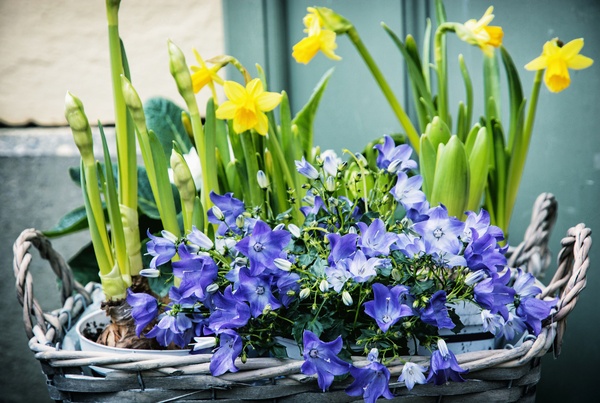
To force daffodil bulbs, you’ll need:
- Daffodil bulbs
- A pot that is large enough to accommodate the bulbs
- Potting mix
- Water
Start by planting the bulbs in the pot, using a good quality potting mix. Water well, and then place the pot in a cool, dark place such as a garage or shed. Leave the bulbs for 12 weeks, during which time they will form roots and start to grow.
After 12 weeks, bring the pot into a warm, light place such as a sunny windowsill. The bulbs will start to grow and bloom within a few weeks. Once the blooms have faded, you can either plant the bulbs outdoors or discard them.
Daffodil Varieties to Try in Your Garden
There are hundreds of different daffodil varieties to choose from, so it’s worth doing some research to find ones that will suit your garden. Here are a few to try…
Tête-à-tête: One of the most popular varieties, ‘Tête-à-tête’ daffodils are compact and produce lots of small, yellow blooms.
Paperwhite: As the name suggests, ‘Paperwhite’ daffodils have pure white blooms. They are really easy to grow and make a great indoor plant.
Geranium: Another popular variety, ‘Geranium’ daffodils have large, bright pink blooms.
Thalia: ‘Thalia’ daffodils are unusual in that they have double blooms. They are also very fragrant, making them a great choice for gardens or patios.
Final Thoughts
So there you have it, everything you need to know about growing daffodil bulbs. With a little bit of care and attention, you’ll be able to enjoy these beautiful flowers in your garden for many years to come.
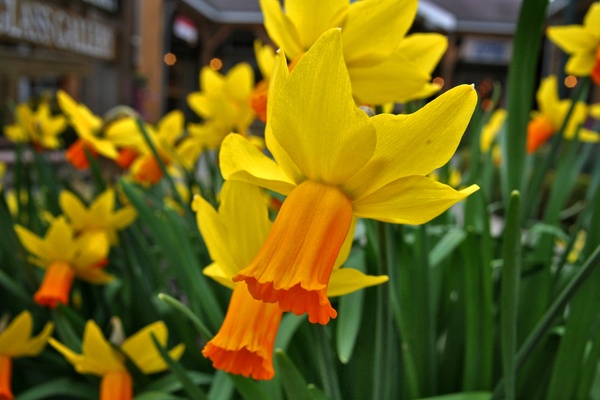
Which are your favourite daffodils? Have you tried any unusual varieties? How do you like to plant your daffodils? Let us know in the comments below.

